Tiger Safari Tour - Corbett, Kanha & Bandhavgarh
13 Nights/14 Days
Tour of Corbett, Kanha, and Bandhavgarh National park
Learn about the wild animals that call the Indian jungle home on a Tiger Safari. Corbett National Park in the north, Kanha National Park in the south, and Bandhavgarh National Park in the centre are all included.
Corbett has earned its moniker as the “land of the roar, trumpet, and song” with good reason: the park is home to a wide variety of animals, including the Royal Bengal Tiger, the Asian elephant, and about 600 different species of birds. What’s more, the Himalayan Foothills and the Ramganga River, with their crystal-clear waters, serve as a magnet for all of this diverse wildlife. In addition, the 100-year-old forest rest home is located in the Dhikala Zone, one of the most sacred parts of the forest, so you may enjoy your stay in a truly wild setting.
The sights of Central India are there for the taking after you’ve seen Corbett. Bandhavgarh boasts one of the greatest Tiger densities, while Kanha is home to some of the largest Tigers in India. Join us on our private tour of Corbett, Kanha, and Bandhavgarh to see this breathtaking scene for yourself.
What you will experience on this tour.
From the best of the Indian wildlife, including the Royal Bengal Tiger, Black Leopard, Snow Leopard, Asiatic Lion, and the Red Panda to premium wildlife lodges, luxury city hotels, experienced naturalists and guides, we cover them all for your must-in-a-lifetime experience of Tiger Safari in India.
Outline Itinerary: Corbett, Kanha & Bandhavgarh Tour
- Day 01 : Arrival in New Delhi
- Day 02: New Delhi – Corbett (Drive 275/5 hour drive)
- Day 03 – 04: In Corbett National Park
- Day 05: Corbett – New Delhi (Drive 275 Kms/ 05-06 hours drive)
- Day 06: New Delhi – Jabalpur – Bandhavgarh (flight + 200 kms/02-hours drive)
- Day 07 – 09: In Bandhavgarh National Park
- Day 10: Bandhavgarh - Kanha (Drive 280 kms/06-hours drive)
- Day 11 – 12: In Kanha National Park
- Day 13: Kanha – Raipur – New Delhi (Drive 200 kms / 04-hours drive)
- Day 14: New Delhi - Onward

Detailed Itinerary Tiger Safari & Taj Mahal Tour of India
Day 01 : Arrival in New Delhi
You will be met by our representative when you arrive at the New Delhi airport, and they will transfer you to your hotel and help you with the check-in process. He will also hand over any travel documents that are necessary and provide you with a briefing on your upcoming trip. The hotel is where you will be staying for the night.
Accommodation: The Roseate House, Aerocity or similar
Day 02: New Delhi–Corbett (Drive 275/5-Hour Drive)
After an early breakfast, drive 275 kilometres (5 hours) to Corbett National Park. With your luggage, transfer to a tiger safari vehicle at the park’s entrance. Prepare your camera for the next 32 km, 1.5-hour trip will take you into the core region of the national park, where you will have a high opportunity of seeing wildlife such as Tigers, Leopards, and Asian Elephants. Check into the forest lodge upon arrival. After lunch, go on an afternoon tiger safari.
Living at the Forest Rest House is an experience that is unique to Corbett National Park. Only in Corbett do you have the option of staying inside the national park. The complex is situated on the banks of the Ramganga river and overlooks the Himalayan foothills. Both alcohol and smoking are not authorised. At sunset, return from the safari. Dinner and a night’s stay at the Forest Rest House.
Accommodation: Dhikala Forest Rest House
Day 03 – 04: In Corbett National Park
Morning and afternoon jeep tiger safaris, dinners, and overnight stay at the Dhikala Forest Lodge within Corbett National Park.
Begin your tiger safari in the morning at sunrise. Corbett has been appropriately dubbed the “Land of the Roar, Trumpet, and Song.” It depicts a breathtakingly beautiful scene. Corbett National Park was the delighted recipient of the honour of hosting the launch of Project Tiger in India. The range of ecosystems in the Reserve contributes to the Reserve’s remarkable biodiversity. The Reserve contains both Himalayan and peninsular flora and wildlife due to its location in the central Himalayan foothills.
Established on August 8, 1936, as Hailey National Park in honour of Sir Malcolm Hailey, the then-governor of the United Provinces, the park’s name was later changed to Ramganga National Park in 1952, and then to Corbett National Park in honour and memory of the late Jim Corbett, the legendary hunter, naturalist-turned-author and photographer who assisted in the establishment and demarcation of the park’s boundaries.
Dinner and a night’s stay at the Forest Rest House.
Dhikala Forest Rest House provides lodging.
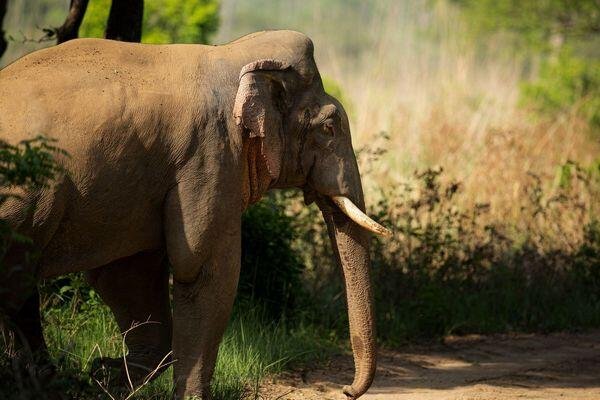
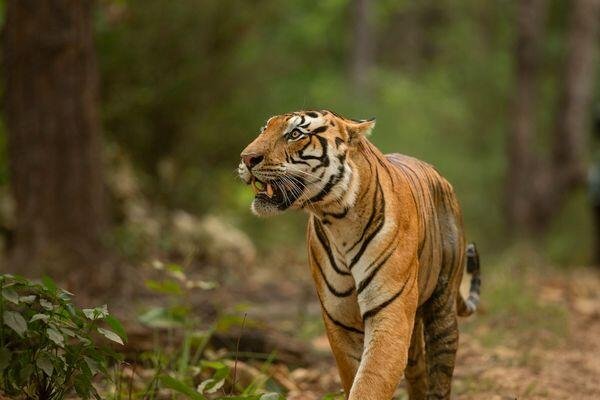
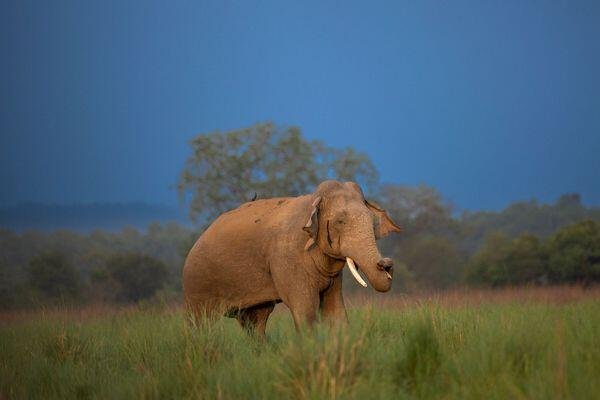
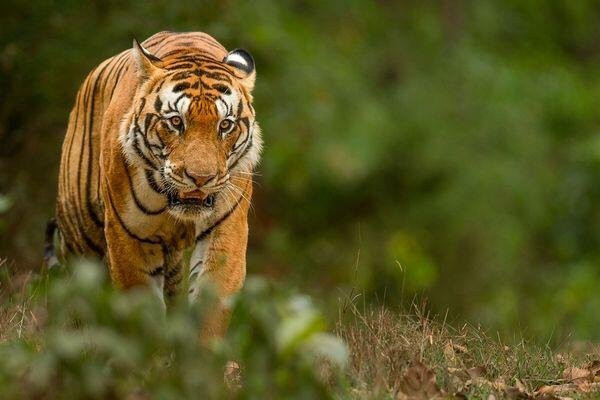
Day 05: Corbett – New Delhi (Drive 275 Kms/ 05-06 hours drive)
Jeep tiger safari in the morning to Dhikala zone. After breakfast, check out of the accommodation and drive to the Corbett departure gate. Don’t forget to bring your camera because you might see some wildlife on your way out. After leaving the park, drive 275 kilometres to New Delhi, which takes around 5 hours. Stay in a hotel in New Delhi for the night.
Accommodation: Roseate House, Aerocity, or something comparable
Day 06: New Delhi – Jabalpur – Bandhavgarh (flight + 200 kms/02-hours drive)
Leave for New Delhi Airport at 05:55 a.m., after breakfast. Bandhavgarh National Park is a 220 kilometre (4 hour) trip from Jabalpur. Upon arrival, you will meet our representative at the airport. Upon your arrival, please check in at the lodge. After you’ve had lunch, it’s time to go on a jeep safari in Bandhavgarh National Park in search of tigers. In the lodge for the night, complete with dinner.
The Tree House Hideaway or a place like it
Day 07 – 09: In Bandhavgarh National Park
In-lodge breakfast, lunch, and dinner service is provided. Jeep safaris to see tigers at Bandhavgarh National Park, India, both in the morning and the afternoon.
The tiger population in Bandhavgarh National Park is very large and well-known. The legendary White Tigers of Rewa were found in this region. The park is home to a wide variety of wild animals, such as leopards, blue bulls, Indian bison, chausinghas (four-horned antelopes), spotted deer, sambar deer, wild pigs, sloth bears, foxes, jackals, and wild dogs, among others. The Park is home to over 250 different kinds of birds and at least 22 different types of mammals. Cobras, Kraits, Vipers, Rat snakes, Pythons, Monitor Lizards, and turtles are just few of the reptile species that call this park home. Bandhavgarh is home to two types of primates: rhesus macaques and Hanuman langurs. For over two millennia, the park has served as a thriving community hub. Ancient texts like the Narad-Panch Ratra and the Shiva Purana both make mention to it.
The caves hewn into the sandstone to the north of the fort are the oldest evidence of human occupation in the park. Many of them have Brahmi inscriptions from the 1st century BCE. The fort has changed hands between several dynasties over the centuries, including the Maghas in the 1st century CE and the Vakatakas in the 3rd century CE. The Chandela dynasty was one of many that followed to rule Bandhavgarh. Bandhavgarh was the private property of the Maharaja of Rewa after India gained independence from Britain, but he donated it to the state in 1968 so that it could be turned into a national park. The park’s establishment led to a significant increase in wildlife numbers as poaching and hunting were curbed. In particular, tigers thrived when the 1986 addition supplied additional forest.
Stay in the lodge for the night.
Places to stay: Tree House Hideaway or something similar
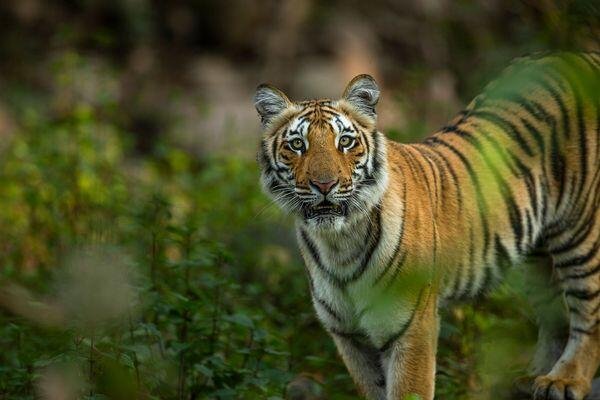
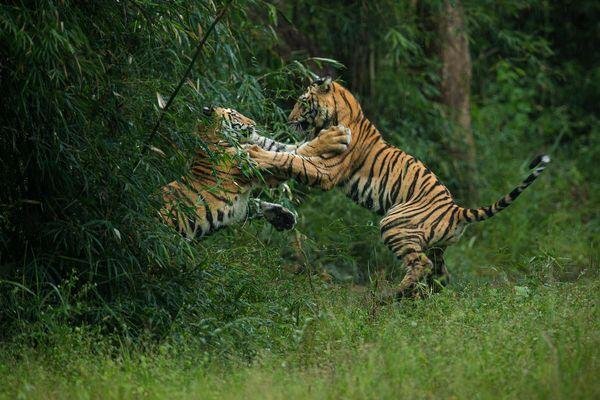
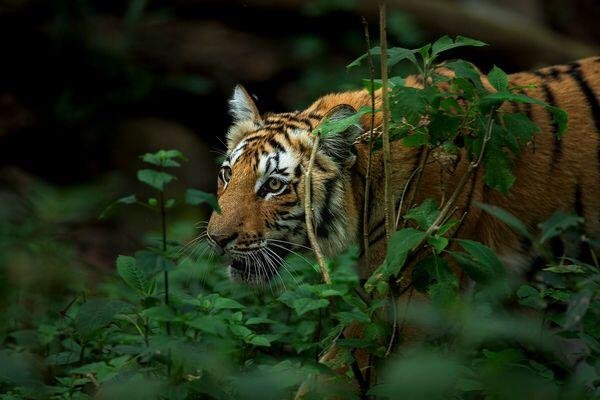
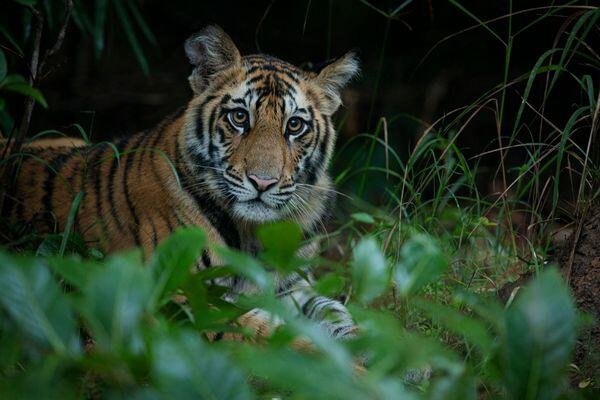
Day 10: Bandhavgarh-Kanha (Drive 280 kms/06-hour drive)
Trip to Kanha National Park includes a morning jeep safari and a trip to the park after lunch (280kms, 6-hour drive). The Lodge awaits your arrival. Eat dinner and stay the night at the Lodge.
Stay at the Singinawa Jungle Lodge or a comparable establishment
Day 11–12: In Kanha National Park
Get up for a morning tiger safari in Kanha National Park at 0500 hours with some tea/coffee and biscuits.
The 940 square kilometres of Kanha’s ssal and bamboo forests, rolling grasslands, and flowing streams make up the reserve’s spectacular natural grandeur. The park, established in 1974 as part of Project Tiger, is home to the critically endangered hardground Barasingha (Cervus Duvaceli Branderi).
This is the land that inspired Rudyard Kipling to create his evocative depiction of the jungle in The Jungle Book. The Lodge provides a packed breakfast, which is put out on the safari vehicle’s bonnet and eaten at a predetermined location. In the early morning, you can enjoy the wilds of Kanha while having breakfast.
If you haven’t seen the rare tiger yet, keep looking while taking in the revitalising atmosphere. We recommend getting back from your safari no later than 11:30. Get cleaned up while I make lunch.
After lunch, head out to Kanha National Park for an afternoon jeep safari to spot tigers. Kanha National Park was established in 1955 under a special statute. Since then, numerous comprehensive conservation initiatives have been implemented to ensure the long-term safety of the park’s wildlife and plants. Nearly 38 animal species have been spotted in Kanha. The largest bovine in the world, the largest Indian deer, and the only four-horned antelope in the world all make their homes in this park. Nilgai antelope, sloth bears, dholes (Indian wild dogs), and even the rare Leopard are also regular visitors. Storks, egrets, black ibis, raptors, owls, and nightjars are just a few of the more than 300 bird species that call this park home.
The safari ends at 6 o’clock, so you better get back. There will be dinner and lodging at the Lodge.
Stay at the Singinawa Jungle Lodge or a comparable establishment
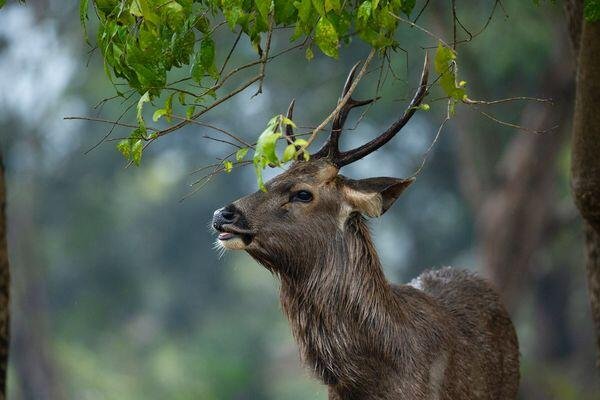
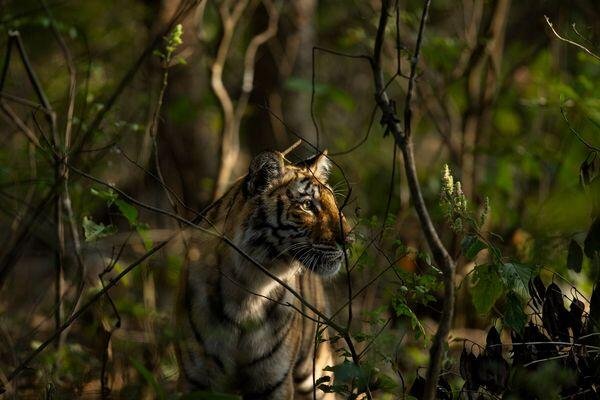
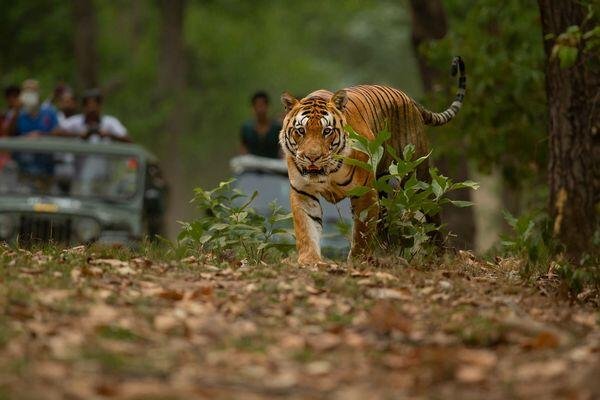
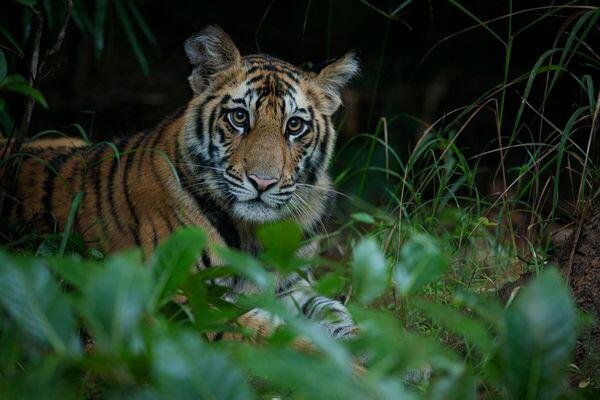
Day 13: Kanha – Raipur – New Delhi (Drive 200 kms, 04-hour drive)
Early morning Jeep trip in Kanha’s tiger reserve. Plan on leaving for the airport in Raipur (a four-hour drive away) after lunch to catch a flight to New Delhi. Transport to the hotel upon arrival in New Delhi. Staying in a hotel for the night.
Lodging: The Roseate, Aerocity, or a comparable establishment
Day 14: New Delhi - Onward
Get dropped off at the international airport in time to catch your trip back home or onward.
Trusted by
Get a Quote
Reach Us!
Let’s plan your tiger safari tour in India. You can use the query form at the bottom of the page or use the following to connect us.
Phone
Request Callback
What you will experience on this tour.
From the best of the Indian wildlife, including the Royal Bengal Tiger, Black Leopard, Snow Leopard, Asiatic Lion, and the Red Panda to premium wildlife lodges, luxury city hotels, experienced naturalists and guides, we cover them all for your must-in-a-lifetime experience of Tiger Safari in India.
Tour Inclusions
- Bed and breakfast accommodations are available in New Delhi and Agra.
- Accommodations include all meals and a safari in Pench, Kanha, and Bandhavgarh.
- Your Pench, Kanha, and Bandhavgarh admission and guide fees.
- Your entry fee and any tour guide fees for visiting monuments.
- There will be 6 exclusive jeep safaris offered in Pench.
- In Kanha, 5 exclusive jeep safaris will be offered.
- In Bandhavgarh, there will be 7 exclusive jeep safaris available.
- Assistance at the hotels and the airport.
- Every land transfer is done in a cool Toyota Innova or Crysta.
- Any taxes that are now applied.
Tour Exclusions
- Both domestic and international plane travel.
- Personal expenses like tips, cigarettes, alcohol, laundry, and phone calls.
- In national parks and monuments, there is a still and video camera fee.
- Travel Insurance
- Everything that isn't listed among the inclusions.
Enquire this tour
Other Wildlife Safari Tours in India to choose from
Kanha, Bandhavgarh, and Kaziranga National Park are recognised for its wildlife adventures with Tigers, Gaurs, Wild Dogs, Barasinghas, water buffaloes, birds, and the one Horned Rhino.
Bandhavgarh National Park is a prime tiger safari park in central India.
This little park boasts one of the greatest tiger concentrations in the country. Every curve on a Bandhavgarh tiger safari has its own narrative.


